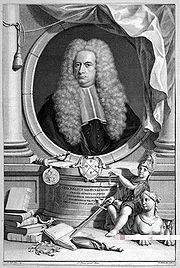
Cornelius Bynkershoek
Encyclopedia

Middelburg
Middelburg is a municipality and a city in the south-western Netherlands and the capital of the province of Zeeland. It is situated in the Midden-Zeeland region. It has a population of about 48,000.- History of Middelburg :...
– 16 April 1743, The Hague
The Hague
The Hague is the capital city of the province of South Holland in the Netherlands. With a population of 500,000 inhabitants , it is the third largest city of the Netherlands, after Amsterdam and Rotterdam...
) was a Dutch
Netherlands
The Netherlands is a constituent country of the Kingdom of the Netherlands, located mainly in North-West Europe and with several islands in the Caribbean. Mainland Netherlands borders the North Sea to the north and west, Belgium to the south, and Germany to the east, and shares maritime borders...
jurist
Jurist
A jurist or jurisconsult is a professional who studies, develops, applies, or otherwise deals with the law. The term is widely used in American English, but in the United Kingdom and many Commonwealth countries it has only historical and specialist usage...
and legal theorist who contributed to the development of international law
International law
Public international law concerns the structure and conduct of sovereign states; analogous entities, such as the Holy See; and intergovernmental organizations. To a lesser degree, international law also may affect multinational corporations and individuals, an impact increasingly evolving beyond...
in works like De Dominio Maris Dissertatio (1702); Observationes Juris Romani (1710), of which a continuation in four books appeared in 1733; the treatise De foro legatorum (1721); and the Quaestiones Juris Publici (1737). Complete editions of his works were published after his death; one in folio at Geneva in 1761, and another in two volumes folio at Leiden in 1766.
Van Bynkershoek was especially important in the development of the Law of the Sea
Law of the sea
Law of the sea may refer to:* United Nations Convention on the Law of the Sea* Admiralty law* The Custom of the Sea...
. In particular he furthered Hugo Grotius idea that coastal states have a right to the adjoining waters the width of which had to correspond to the capacity of exercising an effective control over it, that he expressed in his famous book De Iure Belli Ac Pacis. Bynkershoek translated Grotius idea into practical terms, by arguing that such effective control has to correspond to the range of the coastal state's weapons: "terrae potestas finitur ubi finitur armorum vis". However, it was not him, but the Italian Ferdinand Galiami who calculated the range of the most advanced cannon at the time to three nautical miles or a league. This idea became common practice and was known as the "cannon shot rule" and was regarded as the internationally accepted measure of the width of the territorial sea.

